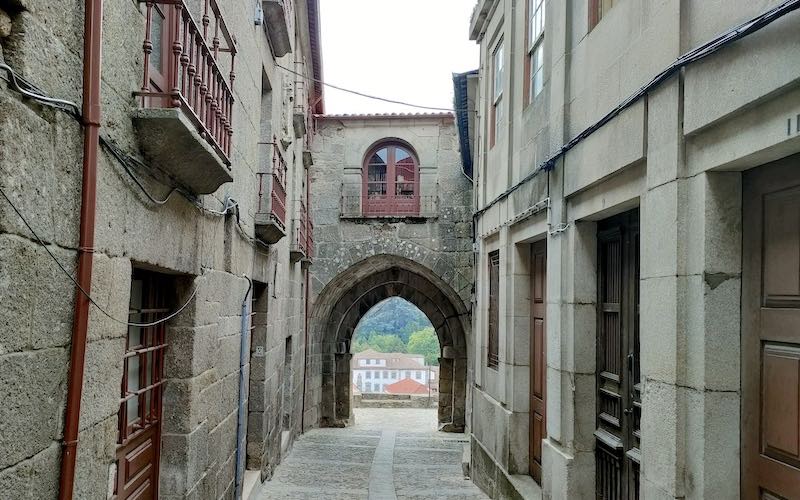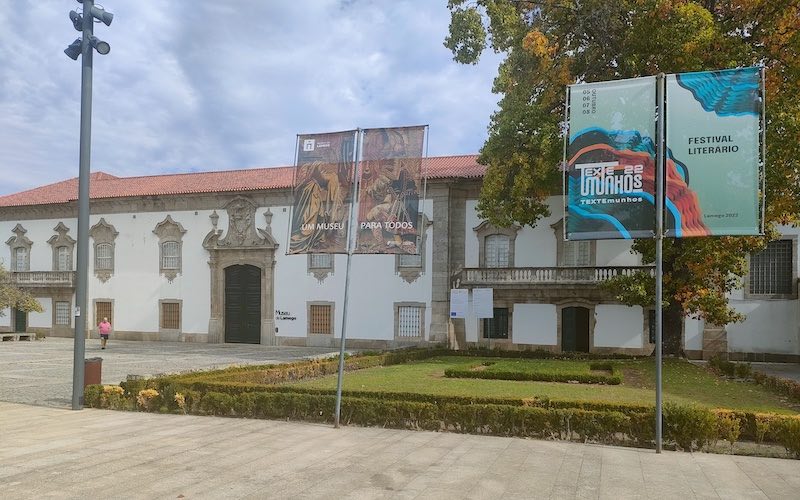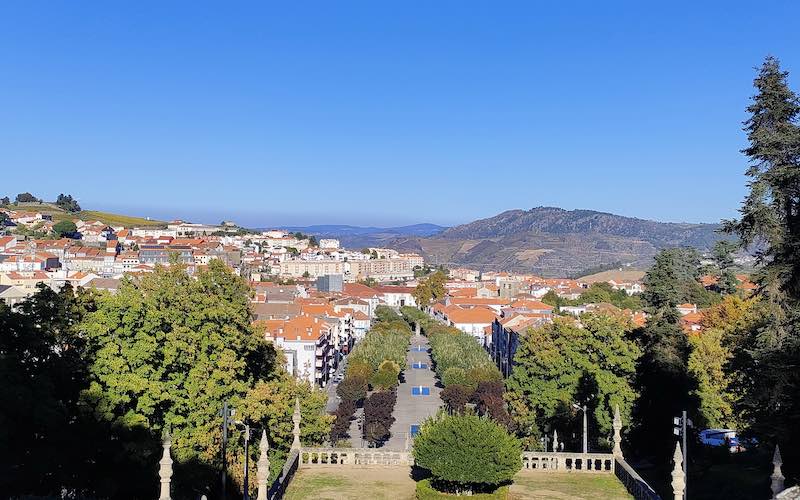I’m actually writing this blog from Lamego bus station. I stayed for two nights here, waling these streets, visiting the best sites and eating in the gorgeous cafes and restaurants. You will be pleased to know that as it’s just a small town, it’s enough to spend one day in Lamego.
Is Lamego worth visiting?
Lamego is in my opinion an often overlooking Portuguese destination in favour of the big cities (Lisbon and Porto) and Braga and Guimaraes. But Lamego is definitely worth visiting. It’s home to one of the most beautiful sites in Portugal – the Sanctuario de NOSSA Senhora Renedios (the Catholic church with blue tiled staircase). If you are into Churches, history and good food then don’t miss this place!
Where to stay in Lamego
Although it is possible to see Lamego in a day I still recommend that you stay one or two nights. This is so that you can enjoy it without feeling rushed and walk up to the castle first thing in the morning.
I stayed at Solar dos Pechos which was basic but had everything I needed included breakfast and wifi. The location was very central and it was good value for money.
What to do in Lamego
The main sites of Lamego are a bit of an uphill walk, so get your good walking boots on! Also go early to avoid the heat of the day especially in the summer months when it can reach 30 degrees.
Sanctuario Nossa Senhora Remedios
The Sanctuary of Our Lady of Remedies (Sanctuario Nossa Senhora dos Remédios in Portuguese) is a Marian shrine located in the city of Lamego, Portugal. This beautiful Catholic church overlooks the main walkway of Lamego – you can’t miss it. It is an important place of pilgrimage for Catholics, and it is a popular tourist destination in the region.
The sanctuary is dedicated to the Virgin Mary, and it is home to a famous statue of Our Lady of Remedies, which is believed to have miraculous powers. The statue was brought to Lamego in the 17th century, and it has been an important object of devotion for Catholics in the region ever since.
The sanctuary is located on a hill overlooking the city, and it is accessed by a series of steps that are known as the “Stairway of the Pilgrims” (Escadaria dos Peregrinos). The stairway has 686 steps and is lined with chapels and shrines that are dedicated to various saints and martyrs. At the top of the stairs, there is a large plaza that leads to the sanctuary itself.
The sanctuary is a beautiful and ornate building, with a Baroque façade and a dome. Inside, there is a chapel that contains the statue of Our Lady of Remedies, as well as several other chapels and altars. The sanctuary is open to the public, and visitors can attend Mass, pray, and explore the building.
Lamego Castle
It’s another upward hike to Lamego castle next. You will follow the winding cobbled streets and go through the Medieval Gate. Follow the path round and locals will direct you – it is quite easy to find.

The Castle itself was built in 10th Century by moorish soldiers to defend the city. In 1057 it was conquered by the Christians. It consists of one main tower and a circular defence wall. It is situated on a hill overlooking the city, and it has a strategic location that allowed it to control access to the Douro Valley.
The castle has a triangular shape, with three towers at its corners. It is surrounded by a moat and has a drawbridge that leads to the main entrance. The castle is made of stone, and it has a number of defensive features, including arrow slits, machicolations, and battlements.
It is free to get in Lamego castle and the staff speak English and are very helpful. The staff will then direct you to carry on to the archaeological museum which is also free.
Archaeological Museum
The archaeological Museum is another free attraction here in Lamego and you can see the original roman city walls and Roman house that were uncovered by archaeologists just 8 years ago when the council bought a house and allowed a dig (time of writing October 2022). There is also a full Hunan skeleton uncovered here that is dated between the 9th and 11th century.
The Lamego Cistern
From the archaeological Museum you can walk down the the cistern which is another free historical attraction.
The Lamego Cistern is a historical site located in the city of Lamego, Portugal. It is a large underground chamber that was used to store water for the city. The cistern was built in the 18th century and is an important example of Portuguese Baroque architecture.
The Lamego Cistern is located in the center of the city, beneath a square called Praça da República. It is a rectangular chamber that measures approximately 30 meters by 15 meters, with a ceiling height of about 5 meters. The walls of the cistern are made of stone, and the floor is paved with tiles.
The cistern was used to store water that was collected from a nearby spring. The water was channeled into the cistern through a series of underground pipes, and it was then distributed to the city through a network of fountains and water faucets. The cistern was in use until the late 19th century, when it was decommissioned and converted into a storage space for the city’s market.
Lamego Museum
The Lamego Museum is a museum located in the city of Lamego, Portugal. It is dedicated to the preservation and promotion of the region’s cultural and historical heritage. The museum is housed in the former Palace of the Counts of Figueira, a 17th-century Baroque building that is itself a national monument.
The Lamego Museum has a number of permanent exhibits that showcase the history and culture of the Douro region. These exhibits include a collection of medieval and Renaissance art, as well as a selection of objects related to the region’s wine industry. The museum also has temporary exhibitions on a variety of topics, such as art, archaeology, and natural history.
In addition to its exhibits, the Lamego Museum offers a range of educational and cultural activities, including guided tours, workshops, and lectures. The museum is a popular destination for both tourists and locals, and it is an important resource for those interested in learning about the history and culture of the Douro region.

Unfortunately the museum was closed when I was there in October 2022. It’s closed for renovations now until 2023.
Lamego Cathedral
Lamego Cathedral, also known as the Cathedral of Our Lady of the Assumption, is a Roman Catholic cathedral located in the city of Lamego, Portugal. It is a national monument and an important example of Portuguese Baroque architecture.
The cathedral was built in the 18th century on the site of an older Romanesque church, and it features a Baroque façade with two towers and a central portal. The interior of the cathedral is richly decorated with frescoes, gilded wood carvings, and marble altars. The cathedral also houses several notable artworks, including a Gothic altarpiece and a collection of 18th-century silverware.
One of the most striking features of the cathedral is its main altar, which is adorned with a large painting of the Assumption of the Virgin Mary. The cathedral also has a number of chapels, including the Chapel of the Blessed Sacrament, the Chapel of the Souls in Purgatory, and the Chapel of St. Anthony.
Lamego Cathedral is an important spiritual and cultural landmark in the city, and it is a popular tourist destination. Visitors to the cathedral can take guided tours or simply explore the building on their own.
Where to eat in Lamego
If you’re looking for places to eat in Lamego, here are a few recommendations:
- O Lusitano – This restaurant serves traditional Portuguese cuisine, including grilled meats and fish, as well as local wine.
- Adega do Pinto – This restaurant is known for its tasty grilled meats and fresh fish dishes, as well as its selection of local wines.
- O Xisto – Located in a historic building, this restaurant serves a variety of traditional Portuguese dishes, including cod and pork dishes, as well as a selection of local wines.
- Tasca do José – This restaurant serves traditional Portuguese dishes, including grilled meats and fish, as well as a selection of local wines.
- A Travessa – This restaurant serves a variety of Portuguese dishes, including seafood, grilled meats, and traditional desserts, as well as a selection of local wines.
These are just a few of the many great restaurants in Lamego. I hope you find a place that you enjoy! Also one more think – don’t forget to try the bolo de Lamego (Lamego cake) in one of the local patisseries – the cod fish one is a must try!
Beyond Lamego
Beyond Lamego, there are a few places that are good to explore if you find yourself wanting to stay more than just one day….
Peso da Régua
Peso da Régua is an important center of the Douro wine industry, and it is home to a number of wineries and vineyards. The city is also home to a number of cultural and historical attractions, including the Solar do Vinho do Porto, a museum dedicated to the history of Port wine; the Nossa Senhora da Piedade Church, a Baroque-style church with a Gothic altarpiece; and the Régua Bridge, a bridge over the Douro River that was built in the 19th century.
Peso da Régua is a popular tourist destination, and it is a great place to visit for those interested in wine, history, and culture. The city is easily accessible by car, and it is also served by a train station that is part of the Douro Line, a historic railway that runs along the Douro Valley.
Capela de São Pedro de Balsemão
Just outside of Lamego (you might need a short car journey or taxi to get there), you will find the Chapel of São Pedro de Balsemão. It is a national monument and an important example of Romanesque architecture in the region.
The chapel was built in the 12th century and is believed to have been constructed on the site of a pagan temple. It is a small, single-nave building with a rounded apse and a semicircular portal. The chapel is made of stone and has a number of decorative elements, including arches, columns, and sculpted figures.
Inside the chapel, there is a Gothic altarpiece and a number of frescoes that depict scenes from the life of Jesus. The chapel also has a number of tombs and funerary slabs, which are decorated with inscriptions and sculptures.
The Chapel of São Pedro de Balsemão is an important historical and cultural site in the village, and it is a popular tourist destination.
Further Reading on Portugal
If you enjoyed this blog and are travelling in Portugal, you might also like to read…
- Jardim do Paco Episcopal
- Monsanto – The Most Portuguese village in Portugal
- Guarda – The Ultimate Travel Guide

